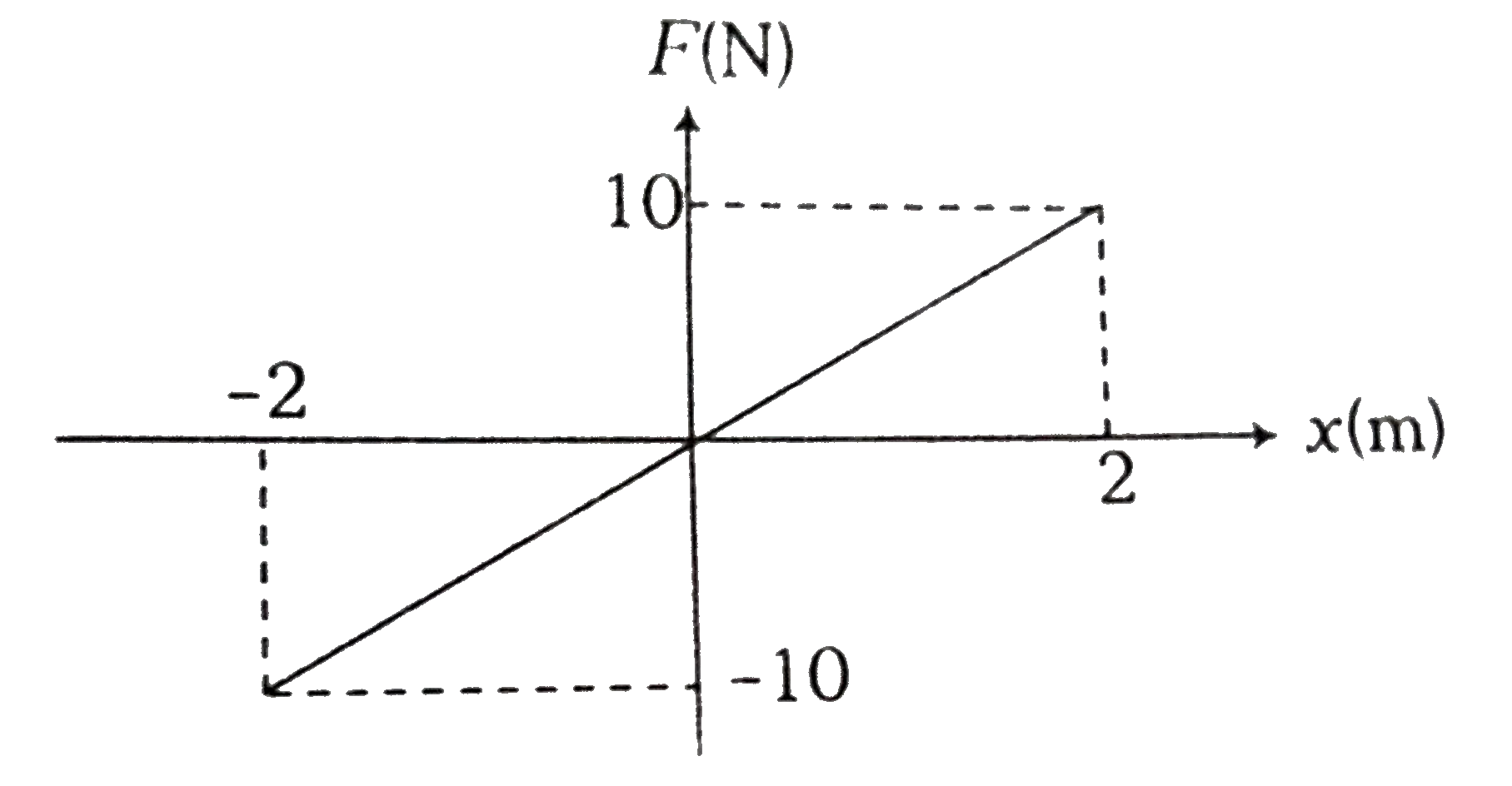A particle experiences a force which is proportional to distance from origin and always directed towards origin. Work done by the force during displacement of the particles from (3,4) to (3,0) is 8 J find the constant of proporionally (all the variable are in S.I unit).
To solve the problem, we need to find the constant of proportionality k for the force that is proportional to the distance from the origin and directed towards it. The work done by this force during the displacement from point (3,4) to (3,0) is given as 8 J.
1. Understanding the Force:
The force →F acting on the particle is proportional to the distance r from the origin. Mathematically, we can express this as:
→F=−k→r
where k is the constant of proportionality, and →r=x^i+y^j is the position vector of the particle.
2. Calculating the Distance:
The distance r from the origin to the point (x,y) is given by:
r=√x2+y2
For the points (3,4) and (3,0):
- At (3,4):
r1=√32+42=√9+16=5
- At (3,0):
r2=√32+02=3
3. Work Done Calculation:
The work done W by the force during the displacement from (3,4) to (3,0) can be expressed as:
W=∫→r2→r1→F⋅d→r
Substituting →F=−k→r:
W=−k∫→r2→r1→r⋅d→r
4. Parameterizing the Path:
The path from (3,4) to (3,0) can be parameterized as:
- x=3 (constant)
- y varies from 4 to 0.
Thus, d→r=3^i+dy^j.
5. Calculating the Dot Product:
The dot product →r⋅d→r becomes:
→r=3^i+y^jandd→r=0^i+dy^j
Therefore,
→r⋅d→r=3⋅0+y⋅dy=ydy
6. Setting Up the Integral:
The work done can now be expressed as:
W=−k∫04ydy
This integral evaluates to:
W=−k(y22)04=−k(0−162)=−k(−8)=8k
7. Equating to Given Work:
We know from the problem statement that the work done is 8 J:
8k=8
Therefore, solving for k:
k=1
Final Answer:
The constant of proportionality k is 1.
The force →F acting on the particle is proportional to the distance r from the origin. Mathematically, we can express this as:
→F=−k→r
where k is the constant of proportionality, and →r=x^i+y^j is the position vector of the particle.
The distance r from the origin to the point (x,y) is given by:
r=√x2+y2
For the points (3,4) and (3,0):
- At (3,4):
r1=√32+42=√9+16=5
- At (3,0):
r2=√32+02=3
The work done W by the force during the displacement from (3,4) to (3,0) can be expressed as:
W=∫→r2→r1→F⋅d→r
Substituting →F=−k→r:
W=−k∫→r2→r1→r⋅d→r
The path from (3,4) to (3,0) can be parameterized as:
- x=3 (constant)
- y varies from 4 to 0.
Thus, d→r=3^i+dy^j.
The dot product →r⋅d→r becomes:
→r=3^i+y^jandd→r=0^i+dy^j
Therefore,
→r⋅d→r=3⋅0+y⋅dy=ydy
The work done can now be expressed as:
W=−k∫04ydy
This integral evaluates to:
W=−k(y22)04=−k(0−162)=−k(−8)=8k
We know from the problem statement that the work done is 8 J:
8k=8
Therefore, solving for k:
k=1
The constant of proportionality k is 1.
Similar Questions
A particle experience a force of 10 N which is constant in magnitude and is always acting towards origin. Calculate the work done by the force on the particle during its displacement from (1,2,3) to (−1,−2,3):
View SolutionA force F acting on a particle varies with the position x as shown in figure. Find the work done by this force in displacing the particle from

View Solution
Knowledge Check
A particle of mass 0.1 kg is subjected to a force which is directly proportional to the distance x. the work done by the force is directly proportional to
AxBx3Cx3/2Dx2
A force f=10+2x acts on a particle moving in straight line on x axis the work done by this force during a displacement from x=0 and x=3m
View SolutionA force F=−kx2(x≠0) acts on a particle in x-direction. Find the work done by this force in displacing the particle from. x=+a to x=2a. Here, k is a positive constant.
View SolutionA force F=a+bx acts on a particle in x-direction, where a and b are constants. Find the work done by this force during the displacement from x1 to x2.
View SolutionA force F=(5+2x) acts on a particle in x direction where F is in newtown and x is meter. Find the work done by this force during displacement from x=0 to x=1m.
View SolutionA force F=(5+2x) acts on a particle in x direction where F is in Newtown and x is in meter. Find the work done by this force during displacement from x=0 to x=1m.
View SolutionA force F=a+bx acts on a particle in the x-directioin, where a and b are constants. Find the work done by this force during a displacement form x=0→x=d.
View SolutionA force F=−kx2(x≠0) acts on a particle in x-direction. Find the work done by this force in displacing the particle from. x=+a to x=+2a. Where, k is a positive constant.
View Solution
